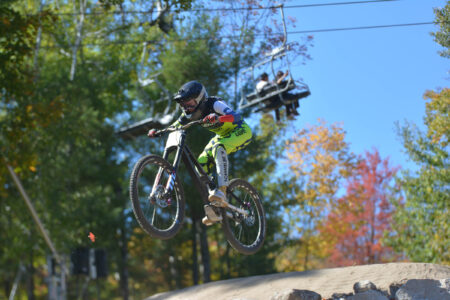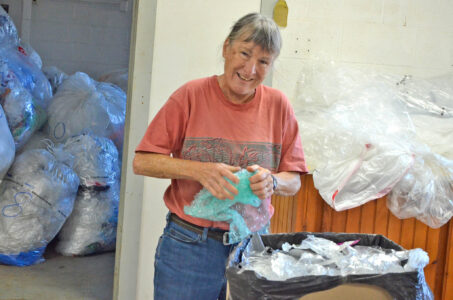Museum sues Lake Placid over eminent domain
Also says it will sue North Elba over new assessment
- The village of Lake Placid wants to use eminent domain to buy these two parcels of land on Main Street downtown from the Adirondack Experience museum and build a parking garage on them as well as on its own adjacent parking lots to the right of this photo. (Enterprise photo — Matthew Turner)

The village of Lake Placid wants to use eminent domain to buy these two parcels of land on Main Street downtown from the Adirondack Experience museum and build a parking garage on them as well as on its own adjacent parking lots to the right of this photo. (Enterprise photo — Matthew Turner)
LAKE PLACID — After lobbing legal threats, the Adirondack Experience has officially sued this village for its attempt to seize the museum’s Main Street property by eminent domain in order to build a public parking garage.
The Blue Mountain Lake institution, formerly known as the Adirondack Museum, is asking the state Supreme Court’s Appellate Division to vacate the village board’s action. The museum asserts there were procedural flaws in the village’s legal steps to acquire the property and that the village failed to demonstrate a need for taking the two parcels at 2476 and 2478 Main St., next to two parking lots the village owns. Village officials want to build a 250-space garage on the two adjacent lots.
“At a public hearing on the issue held on March 13 in Lake Placid, members of the public were virtually unanimous in their rejection of the Village Board’s proposal to build a garage on the site,” the museum wrote in its press release, “and the proposal to use eminent domain to seize the property of a nonprofit institution.
“Despite this,” the release adds, “the Village Board on June 12 held a special meeting during which it issued a determination and findings that there is a public need for the museum’s property. The board meeting was held following the expiration of the 90-day time within which, by law, the Board was required to issue its determination and findings. The Village also failed to hold a public hearing on the environmental impact of the proposed garage project.”
The museum added that in coming days it plans to also file a separate suit against the town of North Elba to reverse what it calls “suspicious punitive actions taken by Town Assessor (Todd Anthony) on March 14 in an apparent effort to pressure the museum and support the eminent domain effort.”

This second suit will be filed in state Supreme Court to seek to have the assessor’s new, lower appraisal of the museum’s properties reversed and the museum’s tax exemption restored.
“The Village of Lake Placid board’s attempt to grab the Adirondack Experience property for pennies on the dollar is unconscionable,” museum Executive Director David Kahn said in the release. “They have damaged the value of the museum’s assets by attempting to manipulate its apparent value through the slight-of-hand reduction of its assessed value. We are confident that the courts will give the museum a fair hearing and put an end to this unprecedented assault on a nonprofit organization.”
Museum officials assert that Lake Placid Mayor Craig Randall and other village officials influenced Anthony to not only remove the museum’s tax-exempt status but also to drop the assessed value of the 0.35-acre property from $1.18 million to $850,000 this year. Randall has said the museum’s claims are “absolutely untrue,” and Anthony also denies them vehemently.
Reached by phone Friday evening, Randall declined comment on the suit, though he said he is aware of it. He redirected comment to the village’s lawyer on the eminent domain proceeding, Patrick Seely of Clifton Park. A message left with Seely’s office in Albany early Friday evening was not returned as of press time.
At the special meeting June 12 when the village board unanimously voted to acquire the museum’s property, Seely said the museum was mistaken in claiming the village illegally held the special meeting and vote outside of the required 90 days. Seely said the vote was held 91 days after the initial March 13 public hearing, and because Sunday, June 11, wasn’t a business day, the village was permitted by law to hold the vote on the 91st day.
At the June 12 meeting, Randall did read aloud a State Environmental Quality Review Act resolution related to the village’s planned Main Street reconstruction project. The village board emphasized that they and their engineer, Ivan Zdrahal, reviewed potential environmental impacts on the area and its residents and determined the project will not result in a significant adverse environmental impact. Zdrahal has said the village would gain 80 to 90 parking spaces with the proposed garage.
The trustees unanimously approved the SEQR resolution immediately before their eminent domain approval.
The parking garage would be a part of the downtown reconstruction.
“This acquisition is necessary to address the amount and location of parking on Main Street in the village,” Randall said aloud at the meeting, reading from the board’s final determination. “This is the best location because the village owns the property next door that will be included in the construction of the proposed parking garage,” he continued, “and (it) is located centrally to the businesses in the Main Street commercial corridor. And there is no significant environmental impact that could not be mitigated with reasonable measures.”
Board members acknowledged that some people were against the parking garage project and/or the use of eminent domain to acquire the museum’s property, but they also stated that no one who spoke up at the March 13 public hearing denied that traffic and parking are problems on Main Street, particularly in the summer and two or three other weeks during the year. The board also disclosed that 16 more written statements were provided through the end of the public hearing period, which concluded March 20. Randall also said none of the written statements asserted that traffic and parking are not problems on Main Street.
For years, many residents have pressured the village to provide more parking downtown, and the museum has faced local friction throughout its Lake Placid experiment. It intended to build a satellite branch in 2007 when it bought the property from the Adirondack Church of the Nazarene. It demolished the church and manse, and planned to construct a glass, wood and stone building with a 64-foot timber tower. The state pledged $1 million, although that later fell through. Local review board members pushed back against the architecture, but the museum finally got its local permit after an arduous eight-month review.
Then in June 2008, the museum announced it had suspended the plan. The reasons it cited were the lengthy permitting processes, a neighbor’s lawsuit over that permit, increased construction costs, fundraising difficulties, a strained economy and the potential effects of high gas prices on museum visitation. Even now, the museum maintains that it is open to revisiting the idea of creating a Main Street visitor center.





